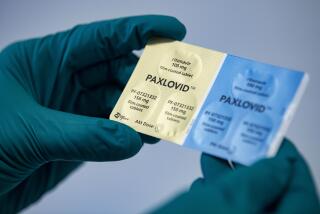Last Days Needn’t Be Spent in Agony
- Share via
After a three-year battle with leukemia, Dennis Shearer was so weak he couldn’t stand. The 52-year-old landscaper’s lungs filled with fluid, his breathing grew labored, his liver began to fail and severe intense pain kept him awake at night.
He died in agony in 1999.
For the record:
12:00 a.m. Aug. 27, 2001 For the Record
Los Angeles Times Monday August 27, 2001 Home Edition Health Part S Page 3 Metro Desk 1 inches; 35 words Type of Material: Correction
Pain treatments--A story about pain treatment in last Monday’s Health section incorrectly stated that the drug Vicodin contains morphine as an ingredient. Vicodin contains hydrocodone, which is an opiate similar to morphine, and acetaminophen.
Although his illness was terminal, his physicians insisted on heroic measures to keep him alive.
“I begged his doctors to put him on a continuous morphine drip,” recalls his widow, Paula Getty-Shearer of Chatsworth. “But up until the last hour of his life, they kept doing tests and procedures, in a futile attempt to extend his life. No one should have to endure the pain he went through.”
Unfortunately, Dennis Shearer’s ordeal is all too common. Medical experts say nearly three of every four people who are facing death experience moderate to severe pain, and that more than half die in pain. Too often, the pain could have been eased--but wasn’t, they say.
Surveys have found that Americans have an acute fear of dying in pain. A 1997 report by the Institute of Medicine, for example, found that the No. 1 fear of people who were dying was the likelihood of being in excruciating pain. And last year a National Institutes of Health study of terminally ill patients and their caregivers found that patients in pain were more likely to consider euthanasia.
“If end-of-life pain was better controlled, we could put Jack Kevorkian out of business,” said Dr. Ira Byock, director of the Practical Ethics Center at the University of Montana in Missoula. “There’s a great deal of knowledge out there. The major gap is in applying what we know.”
Medicine has, in fact, made tremendous strides in the last decade in understanding and identifying pain. Sophisticated and safe treatments are available to effectively control pain in 95% of patients, experts say. Yet each year thousands of Americans suffer needlessly.
Among the obstacles to patients receiving adequate pain relief are a lack of medical training in pain management, the stigma attached to taking narcotics, and institutional roadblocks from health insurance companies and government agencies. Progress in overcoming these stumbling blocks has been slow.
That may soon change, however, because improving pain management is now a priority for medicine, especially as the U.S. population ages. This last January, the Joint Commission on Accreditation of Healthcare Organizations, a national accrediting group for hospitals, issued strict guidelines requiring that pain be treated as a “fifth vital sign,” like blood pressure or heart rate.
And in a landmark California case this last June, an Alameda County jury ruled that a physician was guilty of elder abuse because he failed to prescribe strong enough pain medication to an 85-year-old man dying of lung cancer. In the wake of this judgment, a bill was introduced in the California Legislature that would make pain management classes mandatory for physicians and require the California Medical Assn. to discipline doctors who failed to treat pain properly.
But it’s not just a matter of making patients feel more comfortable. Physicians now recognize that poor pain management may even hasten someone’s death. Patients in pain tend to form blood clots, making them more vulnerable to heart attacks and strokes, and the release of stress hormones in reaction to acute pain weakens the immune system, which compromises one’s ability to fight disease.
Yet “significant barriers” to delivering effective treatment persist, said Dr. Russell Portenoy, chairman of the department of pain medicine and palliative care at Beth Israel Medical Center in New York. “Chief among them is the fact that many very good physicians don’t have the knowledge or skills to manage complex cases of pain.”
A 1998 survey by the American Medical Assn. found that only four of 126 U.S. medical schools required students to take even one course on the care of the dying, while the 50 leading medical textbooks made scant mention of the subject. Since then, the AMA developed the EPEC Project (Education for Physicians on End-of-life Care), a program to teach doctors the basics on appropriate care for dying patients. In California last year, pain management and end-of-life care was added to the required curriculum for medical students in the state.
It will take awhile, though, before these new skills become standard practice. In the meantime, many doctors still tend to under-prescribe potent narcotics, in part because they don’t want to be scrutinized by medical boards or the Drug Enforcement Administration. Or they worry that giving too much medication could actually cause a patient’s death. “Many physicians don’t have a grasp of the use of sedation in the eminently dying,” Portenoy said. “They don’t know the fine line between giving enough to make a patient comfortable without cutting off their respiration.”
Time is a factor, too. Busy physicians often have only 10 to 15 minutes to spend with a patient. As a result, palliative prescriptions may be neglected. “Good pain management is time consuming and requires coordinated care among doctors, nurses and other health care people,” said Dr. Perry G. Fine, a professor of anesthesiology at the University of Utah in Salt Lake City. “There is no quick fix.”
Patients also have to take responsibility for ensuring that they get adequate pain relief. Doctors say patients sometimes fail to mention their pain to doctors, perhaps believing that they must live with it.
“Studies indicate patients don’t want to talk about their pain in the time they have with their doctors because they don’t want to look or act like bad patients and antagonize their physicians,” said Dr. Kathleen Foley, a neurologist at Memorial Sloan-Kettering Cancer Center in New York. Some patients may be afraid of reporting increased pain because they don’t want to face the implications: of cancer that may have recurred or spread, of an immune system damaged by AIDS, of a medical condition that has taken a scary turn for the worse.
The health care system itself works against patients getting effective pain relief, too.
While Medicare, the federal medical plan for people age 65 and older and disabled people, covers costs for medications in the hospital, it doesn’t pay for outpatient drugs. Consequently, terminally ill patients who want to die at home may have to pay out of pocket for expensive painkilling drugs. Similarly, some health plans may not include heavy-duty painkillers in their drug benefit programs.
To discourage abuse of potent narcotics, doctors must wade through a pile of extra paperwork to prescribe opiate painkillers. In California, for example, physicians are required to fill out special triplicate prescription forms to dispense Schedule II controlled substances. These are drugs like morphine that are approved for medical uses but have the highest potential for abuse.
Unfortunately, only half of the licensed physicians in California with Schedule II privileges have triplicate prescription pads, “mostly because they want to stay under the radar of the DEA,” said Betty R. Ferrell, a research scientist with the City of Hope National Medical Center in Duarte. Also, triplicate prescriptions cannot be refilled unless patients see their doctor every time they need more medicine, and doctors are limited in the number of triplicate prescriptions they can write each month. Consequently, many physicians sidestep the paperwork hassles by substituting less potent drugs that do not require a triplicate form.
What’s more, many pharmacies don’t stock opiates. “If you’re taking care of an elderly parent or a sick relative, getting them pain medication on a Friday can be a nightmare,” Ferrell said.
Lynn Rivera, an oncology nurse at the City of Hope, speaks from experience. Last year, when her husband, Michael Sullivan, was dying of lymphatic cancer, every bone in his body ached. He was taking Vicodin, a pain medication that contains morphine. But he’d wake up in the middle of the night in misery if his pain worsened, and the drug wasn’t strong enough to control it.
Rivera, 50, of San Gabriel persuaded her husband’s doctor to prescribe a lozenge form of a fast-acting opiate drug for these sudden spikes of pain. The doctor, however, had to special order the lozenges--requiring approval from a special committee--because the hospital didn’t stock the lozenges on its formulary, an approved list of drugs. ‘He needed them right away,’ Rivera said. “I called the director of the pharmacy--to no avail. Here it is a Friday night, and my husband is dying at home in agony.”
Rivera finally persuaded the doctor to write a triplicate prescription, which she filled at the hospital where she worked in Duarte. “At least I had a place to go--most people don’t,” she said. “But it was sheer madness.”
Some patients fear the use of opiates because they associate them with junkies desperate for a fix and other troublesome images. They worry they’ll become zombies, will become addicted or develop a tolerance that will render the medications ineffective when they really need them. “Even if they’re dying, people don’t want to be thought of as addicts or lost in a mental cloud, which robs them of who they are,” Foley said. “The elderly especially assume that being in pain is an inevitable part of the aging process.”
The reality, however, is that patients don’t have to suffer. Patients can take narcotics for a long time without becoming addicted or having the drugs lose their effectiveness. “There is no ceiling for opiates,” Foley said. “You can continually up the doses, and they will still be potent.” Side effects, such as constipation, loss of mental acuity, drowsiness or nausea, can be minimized either by taking other medications or introducing the drug slowly to give the body time to adjust.
Doctors also now have an extensive pain management arsenal that can control even the most severe cancer pain. Depending on the location of the pain, they can also use different methods of dispensing the medications to ensure they go where they can do the most good--and get there quickly.
With the right medication, the terminally ill can die comfortably. When Michael Sullivan died last September at 60, he wasn’t in pain. He was on a continuous morphine drip, with opiate lozenges for any sudden spike in his pain, surrounded by his loved ones.
“He wanted to die in dignity with his pain under control,” Rivera said. “I had to fight every step of the way. But I think we achieved that.”
More to Read
Sign up for Essential California
The most important California stories and recommendations in your inbox every morning.
You may occasionally receive promotional content from the Los Angeles Times.













